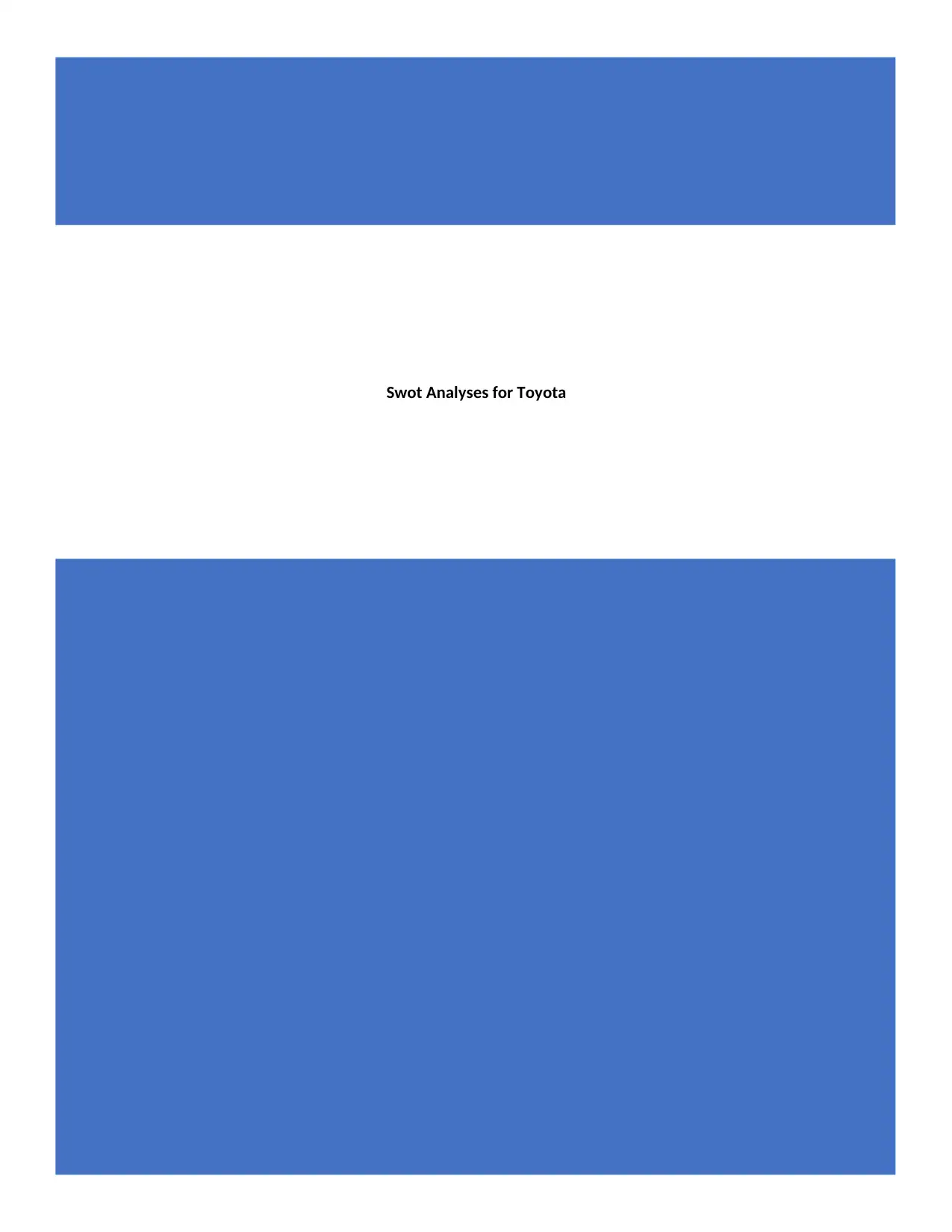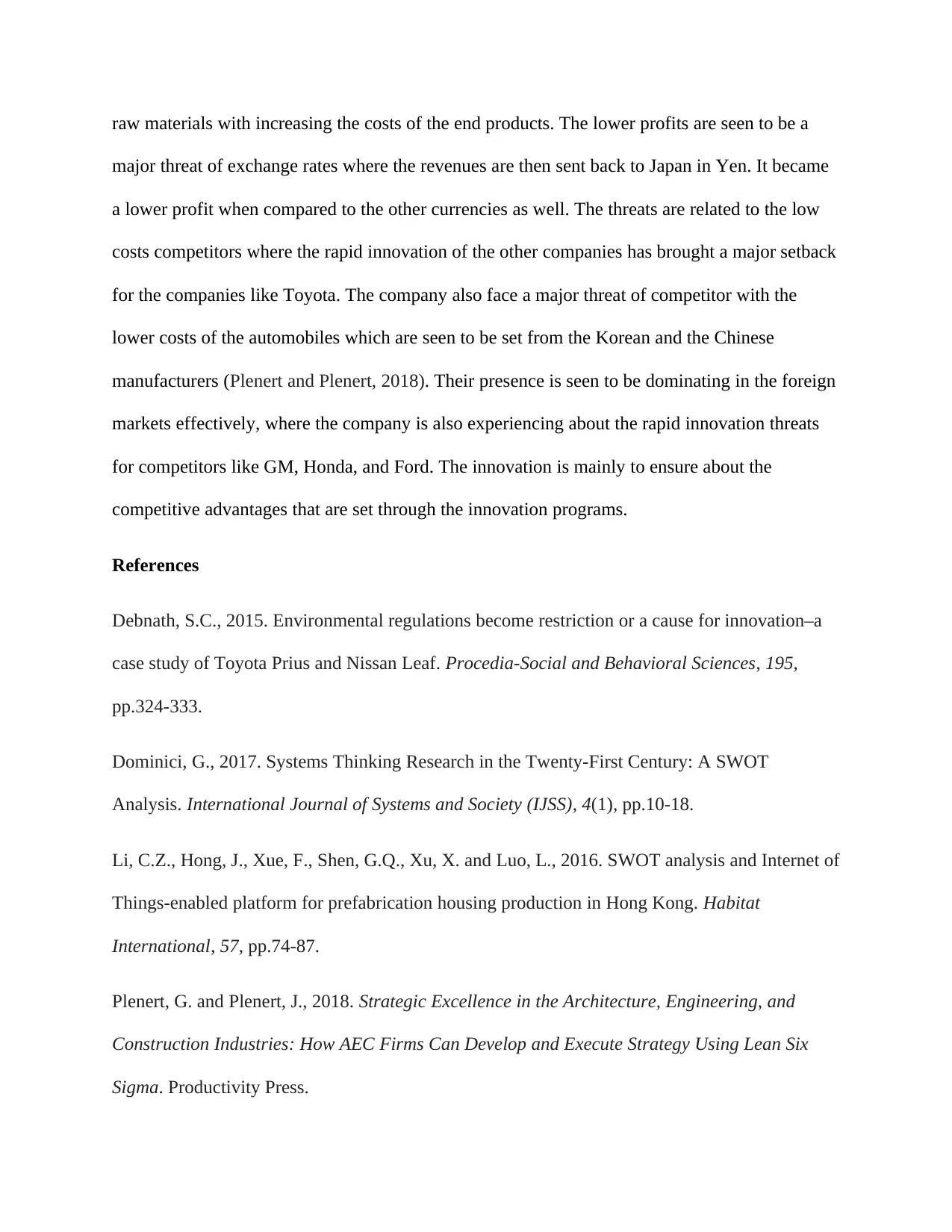Toyota SWOT Analysis: A Comprehensive Review of Business Strategy
VerifiedAdded on 2023/05/31
|5
|1032
|212
Case Study
AI Summary
This case study provides a SWOT analysis of Toyota, evaluating its strengths such as a strong global presence, innovation in hybrid technology, and efficient production capabilities. Weaknesses include dependence on suppliers and challenges in certain markets. Opportunities lie in the growing demand for green vehicles and expanding markets in developing nations. Threats involve intense competition from other automotive manufacturers and fluctuating exchange rates. The analysis emphasizes Toyota's strategic positioning and the factors influencing its market performance, highlighting the importance of innovation and adaptation to maintain a competitive edge. Desklib provides access to this and other solved assignments to aid students in their studies.

Swot Analyses for Toyota
Paraphrase This Document
Need a fresh take? Get an instant paraphrase of this document with our AI Paraphraser

Strength: The stronger points of Toyota professional human resource is to grow big where the
huge power is set throughout the world. They have investments in getting the resources and then
they also get big with better innovation in organization culture. From wide practiced
management systems, to the lean manufacturing details, Toyota has been able to work on
improving the brand image which is considered to be the important point. The strong diversified
portfolio includes different product varieties with advanced technologies that are considered
important as an innovator (Li et al., 2016). The hi-fi technology is introduced for hybrid cars in
the market with global supply chain management. They have been able to reach the outlets,
branch companies and other manufacturing factories which are set in and around the world. A
higher production capability of Toyota gives a major serious competition which is related to
contemporaries on the point with higher capacity production of the cars. The development of
product and operations are considered important especially in producing a better and
environmentally friendly vehicle technologies, with safety of vehicle and a better information
technology (Debnath, 2015). The company is able to work on better research sectors with
forward looking and leading-edge technology development. The product development helps in
upgrading of existing systems effectively. The strong image of the brand and the rapid
innovation generally helps in improving global supply chain which is also a strength that helps in
enabling resilience with the market-based risks minimization.
Weakness: The weakness is about the dependence on suppliers where Toyota has suppliers in
the world and they are depending upon them. This makes the production relatively slower. The
markets of Toyota has been for the green vehicle technology where the failure has been seen to
grab the market with implementation of system accurately. The market of China and India is
considered to be launching the vehicles, but the negative publicity happens when there are recalls
huge power is set throughout the world. They have investments in getting the resources and then
they also get big with better innovation in organization culture. From wide practiced
management systems, to the lean manufacturing details, Toyota has been able to work on
improving the brand image which is considered to be the important point. The strong diversified
portfolio includes different product varieties with advanced technologies that are considered
important as an innovator (Li et al., 2016). The hi-fi technology is introduced for hybrid cars in
the market with global supply chain management. They have been able to reach the outlets,
branch companies and other manufacturing factories which are set in and around the world. A
higher production capability of Toyota gives a major serious competition which is related to
contemporaries on the point with higher capacity production of the cars. The development of
product and operations are considered important especially in producing a better and
environmentally friendly vehicle technologies, with safety of vehicle and a better information
technology (Debnath, 2015). The company is able to work on better research sectors with
forward looking and leading-edge technology development. The product development helps in
upgrading of existing systems effectively. The strong image of the brand and the rapid
innovation generally helps in improving global supply chain which is also a strength that helps in
enabling resilience with the market-based risks minimization.
Weakness: The weakness is about the dependence on suppliers where Toyota has suppliers in
the world and they are depending upon them. This makes the production relatively slower. The
markets of Toyota has been for the green vehicle technology where the failure has been seen to
grab the market with implementation of system accurately. The market of China and India is
considered to be launching the vehicles, but the negative publicity happens when there are recalls

of larger vehicles. There are problems of hierarchical organizational structure where the effects
of products to be recalled in recent years needs to be handled through adjustments to reduce the
weakness which is based on a particular structure of organization. This part of analysis shows
about how Toyota can work on the improvement through properly emphasizing on the quality of
products delivered to the customers.
Opportunities:
The growth of the developing nations includes the discussions of perspectives which are
changing and now they are mainly inclined towards buying new and trendy cars. The demand of
the cars has been seen to increase with green vehicle technology that is able to focus on getting a
better revenue with innovation (Dominici, 2017). The growing concerns are about the
environmental pollution, where people in the world needs to be concerned about handling
environmental degradation with willingness to do their bit. Hence, this time there is a
requirement to popularize the environmentally friendly sector of Toyota. The markets are
developing with rising demands for a better fuel-efficient automobiles. The growing interests are
seen to be advanced with weak Japanese Yen vs. US Dollar. The developing markets generally
present better opportunities to increase the revenue with further penetration into the markets.
Here, the current trends are for the increased demands and interests that hold a higher fuel
efficiency and advanced electronics present a better opportunity for Toyota for focusing on
innovation and directions (Wang et al., 2017).
Threats:
There are different competitors in the market like Volkswagen, Ford etc. who are finding it hard
to strongly put their feet in the market. The company also has threats due to the high pricing of
of products to be recalled in recent years needs to be handled through adjustments to reduce the
weakness which is based on a particular structure of organization. This part of analysis shows
about how Toyota can work on the improvement through properly emphasizing on the quality of
products delivered to the customers.
Opportunities:
The growth of the developing nations includes the discussions of perspectives which are
changing and now they are mainly inclined towards buying new and trendy cars. The demand of
the cars has been seen to increase with green vehicle technology that is able to focus on getting a
better revenue with innovation (Dominici, 2017). The growing concerns are about the
environmental pollution, where people in the world needs to be concerned about handling
environmental degradation with willingness to do their bit. Hence, this time there is a
requirement to popularize the environmentally friendly sector of Toyota. The markets are
developing with rising demands for a better fuel-efficient automobiles. The growing interests are
seen to be advanced with weak Japanese Yen vs. US Dollar. The developing markets generally
present better opportunities to increase the revenue with further penetration into the markets.
Here, the current trends are for the increased demands and interests that hold a higher fuel
efficiency and advanced electronics present a better opportunity for Toyota for focusing on
innovation and directions (Wang et al., 2017).
Threats:
There are different competitors in the market like Volkswagen, Ford etc. who are finding it hard
to strongly put their feet in the market. The company also has threats due to the high pricing of
⊘ This is a preview!⊘
Do you want full access?
Subscribe today to unlock all pages.

Trusted by 1+ million students worldwide

raw materials with increasing the costs of the end products. The lower profits are seen to be a
major threat of exchange rates where the revenues are then sent back to Japan in Yen. It became
a lower profit when compared to the other currencies as well. The threats are related to the low
costs competitors where the rapid innovation of the other companies has brought a major setback
for the companies like Toyota. The company also face a major threat of competitor with the
lower costs of the automobiles which are seen to be set from the Korean and the Chinese
manufacturers (Plenert and Plenert, 2018). Their presence is seen to be dominating in the foreign
markets effectively, where the company is also experiencing about the rapid innovation threats
for competitors like GM, Honda, and Ford. The innovation is mainly to ensure about the
competitive advantages that are set through the innovation programs.
References
Debnath, S.C., 2015. Environmental regulations become restriction or a cause for innovation–a
case study of Toyota Prius and Nissan Leaf. Procedia-Social and Behavioral Sciences, 195,
pp.324-333.
Dominici, G., 2017. Systems Thinking Research in the Twenty-First Century: A SWOT
Analysis. International Journal of Systems and Society (IJSS), 4(1), pp.10-18.
Li, C.Z., Hong, J., Xue, F., Shen, G.Q., Xu, X. and Luo, L., 2016. SWOT analysis and Internet of
Things-enabled platform for prefabrication housing production in Hong Kong. Habitat
International, 57, pp.74-87.
Plenert, G. and Plenert, J., 2018. Strategic Excellence in the Architecture, Engineering, and
Construction Industries: How AEC Firms Can Develop and Execute Strategy Using Lean Six
Sigma. Productivity Press.
major threat of exchange rates where the revenues are then sent back to Japan in Yen. It became
a lower profit when compared to the other currencies as well. The threats are related to the low
costs competitors where the rapid innovation of the other companies has brought a major setback
for the companies like Toyota. The company also face a major threat of competitor with the
lower costs of the automobiles which are seen to be set from the Korean and the Chinese
manufacturers (Plenert and Plenert, 2018). Their presence is seen to be dominating in the foreign
markets effectively, where the company is also experiencing about the rapid innovation threats
for competitors like GM, Honda, and Ford. The innovation is mainly to ensure about the
competitive advantages that are set through the innovation programs.
References
Debnath, S.C., 2015. Environmental regulations become restriction or a cause for innovation–a
case study of Toyota Prius and Nissan Leaf. Procedia-Social and Behavioral Sciences, 195,
pp.324-333.
Dominici, G., 2017. Systems Thinking Research in the Twenty-First Century: A SWOT
Analysis. International Journal of Systems and Society (IJSS), 4(1), pp.10-18.
Li, C.Z., Hong, J., Xue, F., Shen, G.Q., Xu, X. and Luo, L., 2016. SWOT analysis and Internet of
Things-enabled platform for prefabrication housing production in Hong Kong. Habitat
International, 57, pp.74-87.
Plenert, G. and Plenert, J., 2018. Strategic Excellence in the Architecture, Engineering, and
Construction Industries: How AEC Firms Can Develop and Execute Strategy Using Lean Six
Sigma. Productivity Press.
Paraphrase This Document
Need a fresh take? Get an instant paraphrase of this document with our AI Paraphraser

Wang, X., Li, C., Shang, J., Yang, C., Zhang, B. and Ke, X., 2017. Strategic Choices of China’s
New Energy Vehicle Industry: An Analysis Based on ANP and SWOT. Energies, 10(4), p.537.
New Energy Vehicle Industry: An Analysis Based on ANP and SWOT. Energies, 10(4), p.537.
1 out of 5
Related Documents
Your All-in-One AI-Powered Toolkit for Academic Success.
+13062052269
info@desklib.com
Available 24*7 on WhatsApp / Email
![[object Object]](/_next/static/media/star-bottom.7253800d.svg)
Unlock your academic potential
Copyright © 2020–2025 A2Z Services. All Rights Reserved. Developed and managed by ZUCOL.





